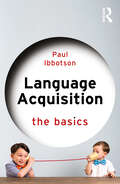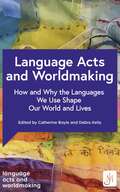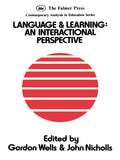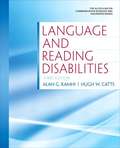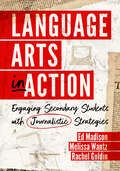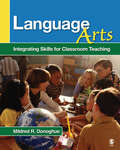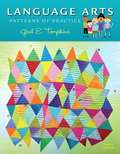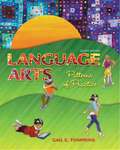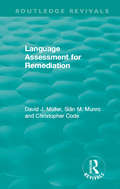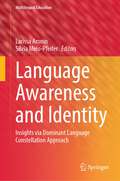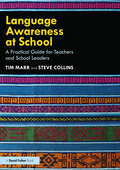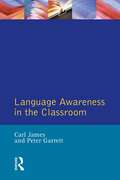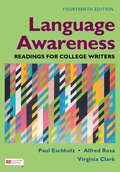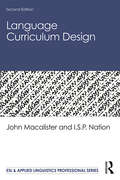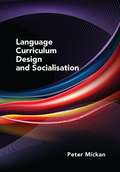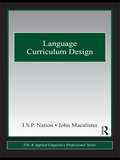- Table View
- List View
Language Acquisition: The Basics (The Basics)
by Paul IbbotsonLanguage Acquisition: The Basics is an accessible introduction to the must-know issues in child language development. Covering key topics drawn from contemporary psychology, linguistics and neuroscience, readers are introduced to fundamental concepts, methods, controversies, and discoveries. It follows the remarkable journey children take; from becoming sensitive to language before birth, to the time they string their first words together; from when they use language playfully, to when they tell stories, hold conversations, and share complex ideas. Using examples from 73 different languages, Ibbotson sets this development in a diverse cross-cultural context, as well as describing the universal psychological foundations that allow language to happen. This book, which includes further reading suggestions in each chapter and a glossary of key terms, is the perfect easy-to-understand introductory text for students, teachers, clinicians or anyone with an interest in language development. Drawing together the latest research on typical, atypical and multilingual development, it is the concise beginner's guide to the field.
Language Across The Curriculum
by Dr V. AmbedkarLanguage is a form and means of communication. It is intimately related to human beings since it is the universal and exclusive characteristic of man alone. It is the product of the human mind and the vocal apparatus which the human being possesses.
Language Activities for Teenagers
by Penny Ur Seth LindstrombergHere are 99 enjoyable activities, for 11-16 year olds, to coax, cajole and tempt them into learning English. The authors, drawing on their own vast experience, share ideas on maintaining discipline, using ice-breakers, warmers, fillers, developing vocabulary and using literature.
Language Acts and Worldmaking: How and Why the Languages We Use Shape Our World and Our Lives
byCollectively authored by the Language Acts and Worldmaking team, this defining volume offers reflective narratives on research, theory and practice over the course of the flagship project of the same name, funded by the Arts and Humanities Research Council's Open World Research Initiative. It returns to the project's key principles - that our words make worlds and we are agents in worldmaking - analyses the practices and outcomes of collaborative working, and looks to the future by offering concrete ideas for how the work they have done can now continue to do its work in the world.Focusing on the key research strands, this volume looks at the role of the language teacher as a mediator between languages and cultures, worldmaking in modern languages, translation and the imagination, languages and hospitality, digital mediations, and how words change and make worlds. Critically, it analyses the impact on communities of living in multilingual cities, and the ways in which learning a first language, and then a second, and so on, plays a crucial role in our ability to understand our culture in relation to others and to appreciate the ways in which they are intertwined.Specific aims are to: · propose new ways of bridging the gaps between those who teach and research languages and those who learn and use them in everyday contexts from the professional to the personal · put research into the hands of wider audiences · share a philosophy, policy and practice of language teaching and learning which turns research into action · provide the research, experience and data to enable informed debates on current issues and attitudes in language learning, teaching and research · share knowledge across and within all levels and experiences of language learning and teaching · showcase exciting new work that derives from different types of community activity and is of practical relevance to its audiences · disseminate new research in languages that engages with diverse communities of language practitioners.
Language Acts and Worldmaking: How and Why the Languages We Use Shape Our World and Our Lives
byCollectively authored by the Language Acts and Worldmaking team, this defining volume offers reflective narratives on research, theory and practice over the course of the flagship project of the same name, funded by the Arts and Humanities Research Council's Open World Research Initiative. It returns to the project's key principles - that our words make worlds and we are agents in worldmaking - analyses the practices and outcomes of collaborative working, and looks to the future by offering concrete ideas for how the work they have done can now continue to do its work in the world.Focusing on the key research strands, this volume looks at the role of the language teacher as a mediator between languages and cultures, worldmaking in modern languages, translation and the imagination, languages and hospitality, digital mediations, and how words change and make worlds. Critically, it analyses the impact on communities of living in multilingual cities, and the ways in which learning a first language, and then a second, and so on, plays a crucial role in our ability to understand our culture in relation to others and to appreciate the ways in which they are intertwined.Specific aims are to: · propose new ways of bridging the gaps between those who teach and research languages and those who learn and use them in everyday contexts from the professional to the personal · put research into the hands of wider audiences · share a philosophy, policy and practice of language teaching and learning which turns research into action · provide the research, experience and data to enable informed debates on current issues and attitudes in language learning, teaching and research · share knowledge across and within all levels and experiences of language learning and teaching · showcase exciting new work that derives from different types of community activity and is of practical relevance to its audiences · disseminate new research in languages that engages with diverse communities of language practitioners.
Language Alternation, Language Choice and Language Encounter in International Tertiary Education
by Bent Preisler Dorte Lønsmann Hartmut HaberlandReflecting the increased use of English as lingua franca in today's university education, this volume maps the interplay and competition between English and other tongues in a learning community that in practice is not only bilingual but multilingual. The volume includes case studies from Japan, Australia, South Africa, Germany, Catalonia, China, Denmark and Sweden, analysing a range of issues such as the conflict between the students' native languages and English, the reality of parallel teaching in English as well as in the local language, and classrooms that are nominally English-speaking but multilingual in practice. The book assesses the factors common to successful bilingual learners, and provides university administrators, policy makers and teachers around the world with a much-needed commentary on the challenges they face in increasingly multilingual surroundings characterized by a heterogeneous student population. Patterns of language alternation and choice have become increasingly important to the development of an understanding of the internationalisation of higher education that is occurring world-wide. This volume draws on the extensive and varied literature related to the sociolinguistics of globalisation - linguistic ethnography, discourse analysis, language teaching, language and identity, and language planning - as the theoretical bases for the description of the nature of these emerging multilingual communities that are increasingly found in international education. It uses observational data from eleven studies that take into account the macro (societal), meso (university) and micro (participant) levels of language interaction to explicate the range of language encounters - highlighting both successful and problematic interactions and their related language ideologies. Although English is the common lingua franca, the studies in the volume highlight the importance of the multilingual resources available to participants in higher educational institutions that are used to negotiate and solve their language problems. The volume brings to our attention a range of important insights into language issues found in the internationalisation of higher education, and provides a resource for those wishing to understand or do research on how language hybridity and multilingual communicative practices are evolving there. Richard B. Baldauf Jr., Professor, The University of Queensland
Language Analysis for the Determination of Origin: Current Perspectives And New Directions (Language Policy #16)
by Monika S. Schmid Peter L. Patrick Karin ZwaanThis comprehensive, up-to-date volume reports on current practices and use of Language Analysis for the Determination of Origin (LADO). Readers will find chapters on how it is done, where it is used, how it is used, and learn about recent developments on the use of LADO reports in judicial practice, and current controversies in the field. LADO is a highly controversial topic, and a relatively new branch of forensic linguistics that is used by most European and some non-European governments. When asylum seekers cannot submit documentary proof of their origin, their language can be analysed in order to assess whether their linguistic profile is in accordance with their stated origin. Around 10,000 such language analyses take place annually. This volume is based on the series of meetings of the Language and Asylum Research Group held between 2010 and 2012 and convened by the editors, and offers a state-of-the art perspective from researchers, practitioners, policymakers and stakeholders working on or with LADO.
Language And Learning: An Interactional Perspective
by John NichollsFirst published in 1985. Routledge is an imprint of Taylor & Francis, an informa company.
Language And Reading Disabilities
by Alan Kamhi Hugh CattsNow more than ever, increased attention has been given to students achieving adequate levels of reading proficiency. Maintaining its strong clinical and research basis, the third edition of Language and Reading Disabilities successfully keeps pace with the rapid changes in our knowledge about language and reading disabilities by providing readers with the most up-to-date advances in research and instruction in reading disabilities. This edition continues to cover a wide variety of theories by comparing and noting the similarities and differences between spoken and written language. This text is broad-based in its coverage of identification, assessment, and treatment of reading and writing disorders.
Language Around the World: Ways we Communicate our Thoughts and Feelings
by Gill BudgellDiscover fascinating facts about communication in all its forms, from around the world and over timeEngaging factual writing introduces young readers to the most interesting aspects of languages, how they evolve and change over time. Humans&’ use of language is one of our distinguishing features. Language allows us to communicate what we think, what we want, what we feel, and what we have learned. Some 100,000 years ago, humans began speaking. Since then, we have developed nearly 7000 languages. Languages are living things; they evolve and change over time. They even travel! People carry their language with them and spread it. Large language families even have their own family trees, such as Spanish, French, English. Different languages can be mixed and combined to create new languages with similar words, pronunciation, and grammar rules. Languages can even become extinct if they are not shared and learned by each new generation. Spoken languages are not the only way we communicate. Sign language, Morse code, semaphore, smoke signals, computer codes - humans have invented numerous ways of communicating. Sharing feelings, thoughts, and ideas through the power of language is an essential part of being human.
Language Arts in Action: Engaging Secondary Students with Journalistic Strategies
by Ed Madison Melissa Wantz Rachel GuldinBuild communication skills that can last a lifetime. To adolescents enthralled by the instant gratification of social media, the pace of classroom routines can seem glacial. How can educators engage today’s “swipe-happy” students and prepare them to thrive in a world where disinformation is as easy to absorb as information? Language Arts in Action is a thoughtful guide for middle and high school educators wanting to reengage their classes with more active, student-centered instruction. Here, teachers will find tools rooted in journalistic learning: a model that uses project-based storytelling to develop critical communication skills. By allowing young people to research, write, and publish articles aligned with their interests, educators can transform language arts, especially for students who feel their experiences and concerns are missing from traditional instruction.
Language Arts: Integrating Skills for Classroom Teaching
by Mildred R. DonoghueProvides a clear and succinct introduction to teaching the language arts to elementary studentsKey FeaturesFocuses on integrating the six language arts—reading, writing, listening, speaking, viewing, and visually representing—with other subject areasProvides guidance on differentiating instruction to bring out the best in the rapidly growing number of students with special needs and English language learners in the regular classroomIncludes a detailed lesson plan in each chapter along with instructional activities and techniques to integrate the language arts across all the subjects in the elementary curriculumAccompanied by High-Quality Ancillaries!Student Resource CD: Bundled with the book, this CD includes video clips and discussion questions that correlate with important chapter concepts.This interactive study site provides practice tests, flashcards, chapter summaries, links to NCTE/IRA and state-specific Language Arts standards, and much more.Instructor Resources on CD: Available by contacting SAGE Customer Care at 1-800-818-SAGE (7243), this CD for instructors offers resources such as lecture outlines, PowerPoint slides, a test bank, and sample syllabi for semester and quarter courses.Intended AudienceThis book is intended for undergraduate and graduate courses in elementary language arts methods, which teaches pre-service teachers and licensure/certification candidates specifically how to teach their students the basics of the six language arts – reading, writing, listening, speaking, viewing, and visually representing.
Language Arts: Patterns Of Practice
by Gail TompkinsThe best selling language arts text in the market, Language Arts: Patterns of Practice continues to ground language arts instruction in the contemporary classroom. Its strengthened focus on the needs of English learners, as well as its new coverage of Common Core Standards for English Language Arts and its integrated treatment of technology as a teaching tool combine to make this new edition an invaluable tool for pre-service and elementary language arts teachers.
Language Arts: Patterns of Practice,8th Edition
by Gail E. TompkinsThe best selling language arts text in the market, Language Arts: Patterns of Practice continues to ground language arts instruction in the contemporary classroom. Its strengthened focus on the needs of English learners, as well as its new coverage of Common Core Standards for English Language Arts and its integrated treatment of technology as a teaching tool combine to make this new edition an invaluable tool for pre-service and elementary language arts teachers.
Language Assessment for Remediation (Routledge Revivals)
by David J Muller Sian M. Munro Christopher CodePublished in 1981, this book describes and critically examines the standardised tests and modes of assessment available and most commonly used by speech therapists, psychologists and educationalists. Tests and other assessment procedures are discussed and therapeutic strategies suggested. Thus, psycholinguistic approaches such as ITPA, the Reynell Developmental Language Scales and the Aston Index; linguistic techniques such as LARSP and phonological assessments are described, and adult disorders as well as childhood problems, are reviewed. There is also a brief consideration of the problem of assessing the language of those not speaking English as a first language. The book serves as a core text for student speech therapists and also as a reference for those practicing or researching in speech therapy, special education and linguistic pathology.
Language Assessment: Principles And Classroom Practices
by H. BrownLanguage Assessment: Principles and Classroom Practices is designed to offer a comprehensive survey of essential principles and tools for second language assessment. Its first and second editions have been successfully used in teacher-training courses, teacher certification curricula, and TESOL master of arts programs. As the third in a trilogy of teacher education textbooks, it is designed to follow H. Douglas Brown's other two books, Principles of Language Learning and Teaching (sixth edition, Pearson Education, 2014) and Teaching by Principles(fourth edition, Pearson Education, 2015). References to those two books are made throughout the current book. <P><P> Language Assessment features uncomplicated prose and a systematic, spiraling organization. Concepts are introduced with practical examples, understandable explanations, and succinct references to supportive research. The research literature on language assessment can be quite complex and assume that readers have technical knowledge and experience in testing. By the end of Language Assessment, however, readers will have gained access to this not-so-frightening field. They will have a working knowledge of a number of useful, fundamental principles of assessment and will have applied those principles to practical classroom contexts. They will also have acquired a storehouse of useful tools for evaluating and designing practical, effective assessment techniques for their classrooms.
Language Awareness and Identity: Insights via Dominant Language Constellation Approach (Multilingual Education #45)
by Larissa Aronin Sílvia Melo-PfeiferThis volume offers a unique insight into multilingualism and sociolinguistic diversity employing the dominant language constellation (DLC) approach. How can novel research inform teaching practices? How do current theories account for multilingual reality in settings as diverse as countries of Western and Eastern Europe and Tunisia and Maghreb? The volume deals with issues of plurilingual identity of teachers and multilingual learners and examines the issues of foreign language teaching both in contexts perceived as monolingual and multilingual Drawing on the intersection of analytic categories such as language repertoire, translanguaging, visuality and narratives, it particularly emphasizes the connections between DLCs, language awareness and identity. The contributors demonstrate how formal language teaching can capitalize on the DLC paradigm and how teacher education programs can use it both as a framework to discuss and as a tool to enhance teacher education and professional development.This volume on DLC as an approach to exploring facets of language awareness and identity presents a very welcome contribution to the study of multilingualism as a complex and dynamic phenomenon. The studies stemming from a range of mainly educational settings in different countries will definitely enhance our thinking perspectives in an area of research with increasing interest. Prof. Dr. Ulrike Jessner, University of Innsbruck (Austria) and University of Pannonia (Hungary)
Language Awareness at School: A Practical Guide for Teachers and School Leaders
by Steve Collins Tim MarrAll too often, schools make decisions about language without a proper understanding of the issues involved. Language Awareness at School addresses this problem by exploring a range of topics related to language, helping teachers to make informed choices about how to best support their students in becoming more confident, aware speakers and writers. Written in collaboration by an academic linguist and an experienced teacher, this essential book combines professional experience and academic expertise to demonstrate how a language-aware approach to education has the potential to transform both whole-school policy and classroom practice. Chapters explore such questions as the misconceptions surrounding the use of ‘Standard English’, teachers’ and students’ local accents, the development of cross-curricular speaking and writing skills and how to reinvigorate Modern Foreign Languages. This book also works to undo damaging prejudices about how students speak, instead highlighting opportunities to encourage students to notice, examine and debate language issues. Language Awareness at School is a crucial read for all teachers, trainee teachers and school leadership teams who want to make more informed decisions regarding language issues in schools.
Language Awareness in the Classroom (Applied Linguistics and Language Study)
by Peter Garrett Christopher N. Candlin Carl JamesLanguage Awareness in the Classroom addresses the central educational question of the impact that explicit language knowledge has on learning and language learning.A substantial Introduction defines the issues and key concepts and relates them to contemporary educational policy and practice in Europe and internationally. The papers are organised into four thematic sections: the extent and nature of language awareness in teacher education; school-based language awareness programmes; tertiary education initiatives and modes of evaluation of language awareness programmes.
Language Awareness with 2020 APA and 2021 MLA Updates: Readings For College Writers
by Paul Eschholz Alfred Rosa Virginia ClarkThis ebook has been updated to provide you with the latest guidance on documenting sources in MLA style and follows the guidelines set forth in the MLA Handbook, 9th edition (April 2021).Explore the pervasive influence of language on our lives while becoming a better academic writer with Language Awareness.
Language Awareness: Readings for College Writers
by Paul Eschholz Alfred Rosa Virginia ClarkThis book features readings on a wide range of language topics, from code-switching and multilingualism to fake news and the rise of AI
Language Conflict in Educational Settings: International Perspectives (Routledge Research in Language Education)
by Adolfo Elizaincín Yliana V. RodríguezLanguage Conflict in Educational Settings: International Perspectives delves into the intriguing intersection of contact linguistics and education, a topic that has been relatively unexplored until now.With contributions from scholars across the globe, the book ventures into the realms of conflict linguistics in educational scenarios. Language contact, often fraught with internal and external conflicts, impacts education significantly. Drawing on scholarship representative of different locations, backgrounds, and disciplinary angles, the authors present studies of pairs and triads of different language families from across the Americas, Africa, Asia, and Europe, ultimately demonstrating how language contact leads to conflict, and how the latter eventually affects education processes and outcomes. Presenting a diverse set of theoretical perspectives and methodologies, it asks to what extent these impacts are detrimental to educational outcomes, and more specifically, how language conflict can impact education in the form of policy, teaching, and learning. As such, it provides essential insights for educators, policymakers, and professionals in the fields of education, linguistics, and cultural studies, offering valuable case studies in the under-researched field of language conflict. It ultimately contributes to the enhancement of education in language contact contexts and fosters a deeper understanding of this critical intersection.This book is an invaluable resource for researchers, scholars, and teacher-educators, offering insights to help understand such an intricate phenomenon, as well as those working across language education, linguistics, and the sociology of language more broadly.
Language Curriculum Design (ESL & Applied Linguistics Professional Series)
by John Macalister I.S.P. NationNow in its second edition, Language Curriculum Design describes the steps involved in the curriculum design process, elaborates and justifies these steps, and provides opportunities for practicing and applying them. Crystal-clear and comprehensive yet concise, the steps are laid out at a general level so that they can be applied in a wide range of particular circumstances. Updated throughout with cutting-edge research and theory, the second edition contains new examples on curriculum design and development and expanded attention on environment analysis, needs analysis, and program evaluation. The process comes to life through plentiful examples of actual applications from the authors’ experience and from published research. Each chapter also includes tasks that encourage readers to relate the steps to their own experience, and case studies and suggestions for further reading. Combining sound research/theory with state-of-the-art practice, Language Curriculum Design is widely applicable for ESL/EFL language education courses around the world.
Language Curriculum Design and Socialisation
by Peter MickanThis book applies social theory to curriculum design and sets out a program for language curriculum renewal for the 21st Century. It includes many examples of text-based curricula and describes a plan for curriculum renewal based on these texts as the unit of analysis for planning, for teaching and for assessment. Underpinned by Halliday's semiotic theory of language, the book combines the theory of language as a resource for meaning-making with learning language as learning to mean. The curriculum design constructs curriculum around social practices and their texts rather than presenting language as grammatical and lexical objects. This work will provide teachers, teacher educators and curriculum planners with a curriculum model for teaching children and adults in different contexts from preschool to adult education as well as serving as a practical guide for students.
Language Curriculum Design: Concepts And Approaches In Action Around The World (ESL & Applied Linguistics Professional Series)
by John Macalister I.S.P NationCrystal-clear and comprehensive yet concise, this text describes the steps involved in the curriculum design process, elaborates and justifies these steps, and provides opportunities for practicing and applying them. The description of the steps is done at a general level so that they can be applied in a wide range of particular circumstances. The process comes to life through plentiful examples of actual applications of the steps. Each chapter includes: examples from the authors' experience and from published research tasks that encourage readers to relate the steps to their own experience case studies and suggestions for further reading that put readers in touch with others' experience Curriculum, or course, design is largely a 'how-to-do-it' activity that involves the integration of knowledge from many of the areas in the field of Applied Linguistics, such as language acquisition research, teaching methodology, assessment, language description, and materials production. Combining sound research/theory with state-of-the-art practice, Language Curriculum Design is widely applicable for ESL/EFL language education courses around the world.
